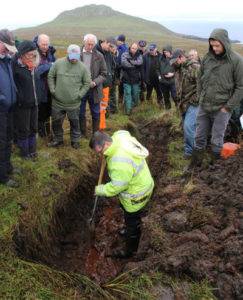Don’t throw your money down the drain – event summary
29 October 2016 While the demonstration of a remote controlled rush cutter proved an attraction and talking point for the strong turnout of crofters and land managers it was more down to earth discussion about field drainage that many focussed on.
While the demonstration of a remote controlled rush cutter proved an attraction and talking point for the strong turnout of crofters and land managers it was more down to earth discussion about field drainage that many focussed on.
With 30 crofters and farmers in attendance Gavin Elrick covered his basic rules about drainage, beginning with a proper understanding of the issues.
Top 11 basic rules about drainage
- Concentrate on best land
- Check all existing open drains and clean out if necessary
- Clean and repair pipe outlets
- Mark pipe outlets so that they can be easily identified (painted post on the ditch bank).
 After cleaning and repairing existing drainage allow system to work for a year before installing any new drains
After cleaning and repairing existing drainage allow system to work for a year before installing any new drains- When weather has been reasonably dry for a period of time (most likely late spring/early summer) check for problem areas
- Carry out test excavations on problem areas to identify problems
- Prepare drainage design to deal with problem
- Install new drains using approved materials
- If gravel backfill is required use clean graded gravel or crushed rock (ideal 20-40mm grade)
- Map any new pipe drains that are installed
Biodiversity and conservation
Elsewhere at the event conservation adviser Gillian McKnight of SAC Consulting highlighted the rich wet grazed grassland habitats on the farm which support valuable plants and breeding farmland waders, such as curlew, snipe and lapwing. These wet grasslands areas depend on agricultural grazing and can be supported financially through agri-environment management grants, and targeted payments for rush cutting and creation of wader scrapes.
Remote cutter
The remote controlled McConnel Robocut, operated by a local contractor, also drew a lot of interest and questions about how best to tackle rushes through soil management and chemical treatment. The machine which can work on slopes up to 55 degree and clear grass or bracken, rushes, gorse and small trees is controlled by an operator standing some distance away from the action, keeping the operator much safer.
View the photo gallery of the event.
Sign up to the FAS newsletter
Receive updates on news, events and publications from Scotland’s Farm Advisory Service


